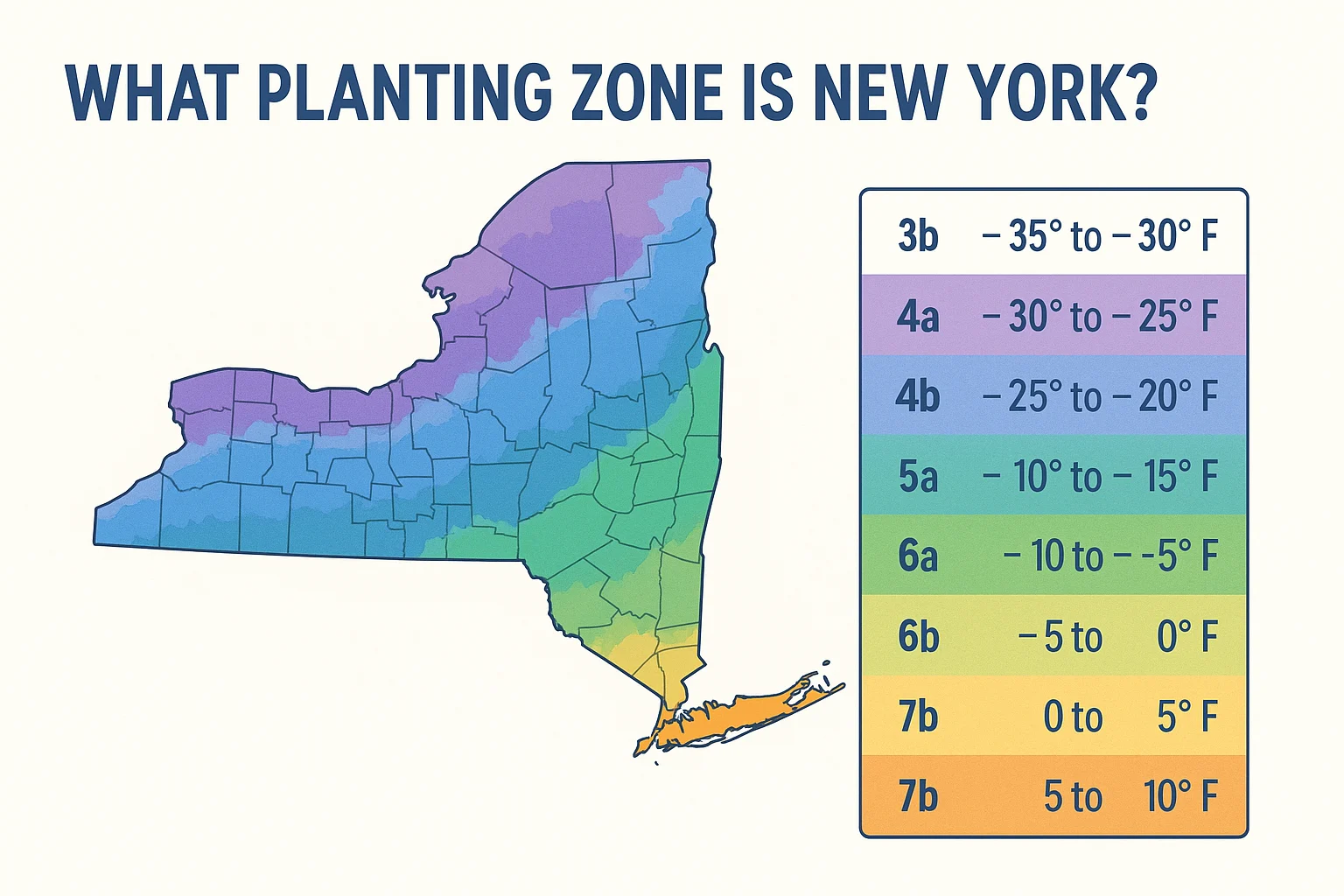What Planting Zone is New York?[Map, Cities, and Growing Tips]

New York’s planting zones range from 3b to 7b, with the majority of the state falling within zones 5a, 5b, and 6a. Northern New York includes zones 3b, 4a, and 4b, while southern New York, including NYC and Long Island, is primarily in zone 7a and 7b.
What is the Planting Zone for New York?
When gardeners ask, “What planting zone is New York in?”, the answer depends on which part of the state you’re in. New York’s planting zone varies widely due to its diverse geography — from the cold Adirondacks to the urban heat island of New York City.
Here’s how New York’s planting zones break down:
- Northern New York (Adirondacks, Tug Hill Plateau): Zones 3b to 4b
- Central & Western New York (Syracuse, Rochester, Buffalo): Zones 5a to 6a
- Hudson Valley & Capital Region: Zones 5b to 6b
- Southern New York (NYC, Long Island): Zones 7a to 7b
This makes the question “What planting zone is New York?” more nuanced than most states. You need to know your local microclimate for accurate planting.
📍 New York Planting Zones by Region
| Region | USDA Planting Zone |
|---|---|
| Adirondacks, Tug Hill | Zones 3b – 4b |
| Central NY (Syracuse) | Zones 5a – 5b |
| Western NY (Buffalo, Rochester) | Zones 5b – 6a |
| Capital Region (Albany) | Zone 5b |
| Hudson Valley (Poughkeepsie) | Zones 6a – 6b |
| NYC (5 Boroughs) | Zone 7a |
| Long Island (South Fork) | Zone 7b |
When people search “What planting zone is New York?”, they’re often looking for this granular breakdown to match their garden’s conditions.
🌡️ Why the Planting Zone New York Matters for Gardeners?
Knowing the planting zone New York is crucial because it determines:
- What perennials survive winter
- When you can plant vegetables outside
- Which trees and shrubs thrive in your location
For example, someone in Zone 7b Long Island can plant fig trees and overwinter rosemary outdoors, while a gardener in Zone 4b near Lake Placid needs hardy apple varieties and frost-tolerant flowers.
Understanding your planting zone New York prevents costly mistakes and improves success.
🗓️ Planting Calendar for New York by Zone
| Crop Type | Zones 3b-4b Start | Zones 5a-6b Start | Zones 7a-7b Start |
|---|---|---|---|
| Cool-Weather Crops | Late April – May | Late March – April | February – March |
| Warm-Weather Crops | Early June | Late April – May | Mid-April |
| Fall Crops | August | Late July – August | July |
If you’re in doubt about what planting zone is New York for your zip code, consult the official USDA map.
🌿 Growing Tips for Planting Zone New York
✅ Do:
- Start seeds indoors 6–8 weeks before last frost
- Use frost blankets for late cold snaps
- Amend heavy clay soils common in Upstate NY
- Choose native plants suited for your specific planting zone New York
❌ Avoid:
- Planting frost-sensitive crops too early
- Ignoring microclimates (urban areas are often warmer)
- Overlooking wind exposure in open regions
🛠️ Recommended Tools for Gardeners in New York
Enhance your garden planning with these:
- Soil Volume Calculator – Know exactly how much soil you need for raised beds.
- Plant Spacing Calculator – Prevent overcrowding and maximize yield.
- Indoor Plant Watering Calculator – Perfect for your houseplants or container garden.
🙋 Frequently Asked Questions About Planting Zone New York
What planting zone is New York City?
New York City is mostly in Zone 7a, with some warmer spots in Zone 7b, particularly in Brooklyn and Long Island City.
What planting zone is Upstate New York?
Upstate New York varies from Zone 3b in the Adirondacks to Zone 6a in cities like Rochester and Syracuse.
Can you grow lavender in New York?
Yes, hardy varieties like English lavender (Zone 5-7) can be grown in much of New York with proper winter protection.
✅ Final Thoughts: What Planting Zone is New York?
When someone asks, “What planting zone is New York?”, it’s not a one-line answer. From icy mountain regions to coastal microclimates, New York’s planting zones require local knowledge. Whether you’re in chilly Zone 4b or temperate Zone 7b, matching your plants to your zone is the key to gardening success.
For precision, always verify your exact planting zone New York by zip code and use it to guide your plant choices.
